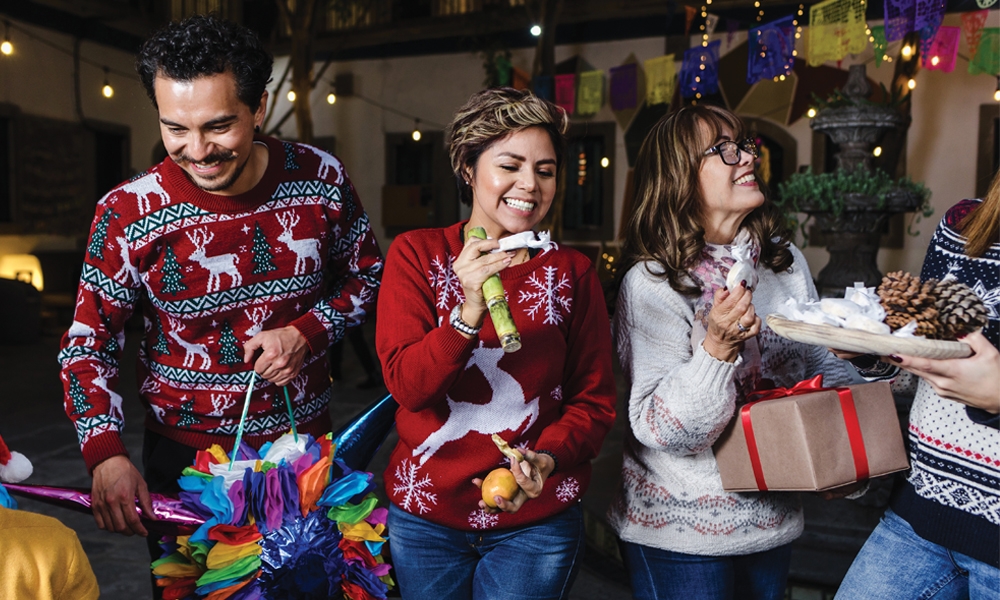
A horn of plenty at El Puente!
There are almost 70 million Hispanics living in the USA, 20 percent of the population. They bring with them a rich culture and a flair for celebration that often follows the liturgical cycle of the Church’s year. Here, Susana Chapa, director of Hispanic ministries for the Diocese of Lansing, unravels some of the Christmas traditions of this vibrant community.
There are almost 70 million Hispanics living in the USA, 20 percent of the population. They bring with them a rich culture and a flair for celebration that often follows the liturgical cycle of the Church’s year. Here, Susana Chapa, director of Hispanic ministries for the Diocese of Lansing, unravels some of the Christmas traditions of this vibrant community.
The stretch of time between the feast of Our Lady of Guadalupe and Epiphany is popularly called Puente Guadalupe-Reyes (the Guadalupe-Kings Bridge). The celebrations themselves begin on December 3 with a novena that precedes the celebration of the Virgin of Guadalupe on December 12. Four days after that another novena called the “Traditional Posadas” begins, culminating on Christmas Day.
Las Posadas begins on December 16. The name means "the inns" or "lodgings." It is a Mexican tradition that reenacts the journey of Mary and Joseph searching for a place to stay in Bethlehem. On Christmas Day, children receive gifts from Baby Jesus and again at Epiphany. This concludes the Puente Guadalupe-Reyes.
Families, churches, schools, neighborhoods, and even restaurants organize their own posadas. The community gathers as a family to celebrate the birth of Jesus. Piñatas, Christmas carols, and traditional food are all part of a posada.
The traditional piñata is made with a clay pot that is filled with typical candy and fruit and decorated with seven spikes and colored paper. Each of the spikes symbolizes one of the seven deadly sins. To break the piñata, the children are blindfolded and take turns trying to break the clay pot with a stick, while also breaking the seven spikes, signifying the importance of breaking the deadly sins in our personal lives. When the piñata is broken, all the children run to catch the candy and fruits that fall to the ground; this symbolizes the rewards of breaking with sin.
Christmas carols are sung with great joy, but the key part of the night is “asking for a posada.” People always ask for posada in front of a door that symbolizes the door that was opened to Mary and Joseph as they looked for a place to spend the night in Bethlehem. The Gospel of Luke narrates that Joseph and Mary had traveled to Bethlehem for the census. Mary was about to give birth and "there was no room for them at the inn" and for that reason, the newborn child was wrapped in swaddling clothes and laid in a manger. (Lk 2:7)
Outside the door, participants ask for posada (hospitality), by singing a song, holding lighted candles in their hands, to symbolize that Jesus is "the light of the world. At first the owner of the inn (posada) does not recognize them, and tells them to go somewhere else, but when he sees that they are Joseph and Mary and that Jesus is going to be born, he opens the doors and gives them lodging. Everyone then enters through the door, more Christmas carols are sung, and they celebrate with the typical food. It is a moment of great joy and celebration for the birth of Jesus.
The posadas promote three fundamental values for society: hospitality, family union, and fraternal bonds.
On Christmas Eve, the last posada is celebrated, and families gather to have dinner together, sing a lullaby, and kiss the figure of the baby Jesus before placing it in the nativity scene to remind us that it was on this night that Jesus came into the world.
After the birth of Jesus, the Three Wise Men visit him and bring gold, frankincense, and myrrh and as gifts. This has led to the tradition of giving gifts to children on Kings Day (Epiphany) and the rosca de reyes (kings’ cake) is decorated with fruit symbolizing the gifts of the kings to Jesus. There is also a figurine of a little boy hidden inside the cake, symbolizing the baby Jesus.
It is vital to keep alive such traditions to remind us, through these visible signs, of the source of our salvation through the birth, life, death, and resurrection of Jesus. ¡Feliz Navidad!
Susana Chapa is the director of Hispanic Ministry at Catholic Diocese of Lansing
